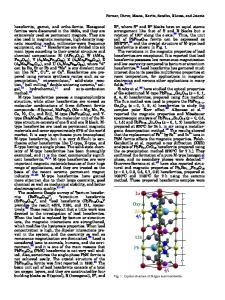Effect of Gd-substitution at Y-site on the structural, magnetic and dielectric properties of Y 1-x Gd x MnO 3 (x=0, 0.05
- PDF / 490,119 Bytes
- 8 Pages / 432 x 648 pts Page_size
- 43 Downloads / 564 Views
Effect of Gd-substitution at Y-site on the structural, magnetic and dielectric properties of Y1-xGdxMnO3 (x=0, 0.05) nanoparticles Samta Chauhan1, Saurabh Kumar Srivastava1, Amit Singh Rajput1,2, Ramesh Chandra1,* 1 Nanoscience Laboratory, Institute Instrumentation Centre, Indian Institute of Technology Roorkee, Roorkee-247667, India 2 Centre of Nanotechnology, Indian Institute of Technology Roorkee, Roorkee-247667, India * Corresponding author Email: [email protected]
ABSTRACT Effect of Gd substitution at Y-site on the structural and magnetic properties of Y1(x=0, 0.05) nanoparticles prepared by conventional solid state reaction method has been studied. The structural study using X-ray diffraction pattern indicates the hexagonal structure with P63cm space group for all the samples. The average particle size for all the samples lies in the range of 30-40 nm as confirmed by X-ray diffraction and transmission electron microscopy analysis. The change in a and c lattice parameters confirm the substitution of Gd at Y-site. Magnetization versus temperature measurements show enhanced magnetic moment and an increase in Neel temperature with Gd-doping. Spin glass behavior is observed at low temperature in all the samples. Exchange bias effect has been observed at 5 K after field cooling the samples which is ascribed to the formation of antiferromagnetic-ferromagnetic (AFM-FM) core-shell structure of the nanoparticles. A significant improvement in the dielectric properties of Gd-doped samples has also been observed. xGdxMnO3
INTRODUCTION Multiferroics are those which exhibit multiple ferroic properties: ferro-magnetic, ferroelectric and ferro-elastic (or at least two of them), combined in the same phase [1-6]. In these materials, the interaction between magnetic and electrical properties leads to control of magnetization by applied electric field and polarization by magnetic field [1]. Since the past few years, substantial research is going on the possibility to couple these ordering effects for applications in spintronics, memory devices, multiple-state logic devices, magneto-electric sensors etc [2,7,9,10]. The hexagonal manganites RMnO3 with R=Ho-Lu and Y have been of particular interest for the detailed studies of the physics of multiferroics. YMnO3 is among the hexagonal rare earth manganites with smaller R3+ ion radii, which belongs to a P63cm space group. The structure comprises of layers of MnO5 bipyramids with one Mn3+ ion surrounded by three in-plane O ions and two apical O ions, separated by layer of Y3+[8]. The in-plane O ions form 2D Mn-O-Mn super-exchange bond giving rise to an antiferromagnetic (AFM) state with TN ~ 70K. The ferroelectric nature (with TC ~ 900K) arises due to the tilting of MnO5 polyhedra combined with displacement of Y3+ ions. In the series of investigation, numbers of research have been carried out to study the effect of doping in YMnO3. Recent studies have focused on the phase transitions in high temperature limit [11] and magnetic phase diagrams of h-YMnO3 [12]. With Cr doping o-YMO
Data Loading...











